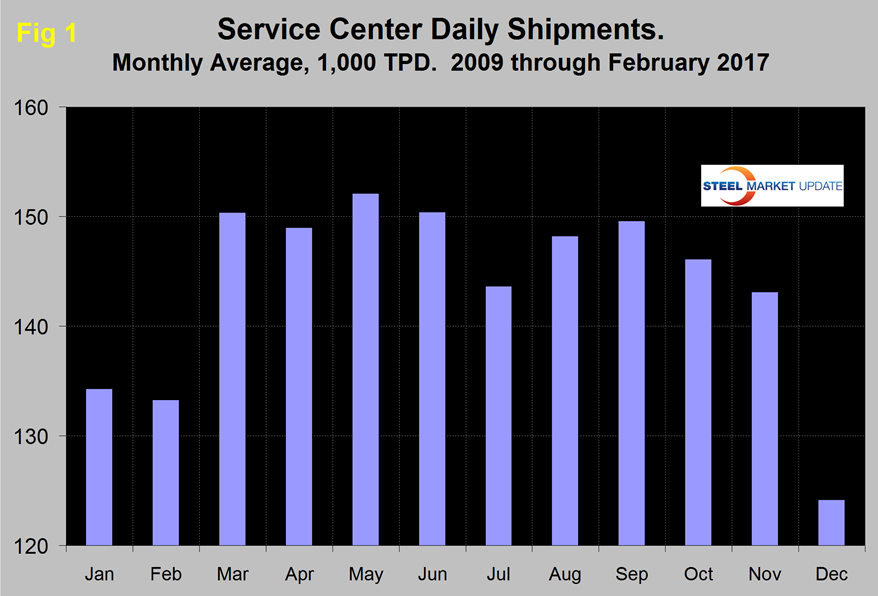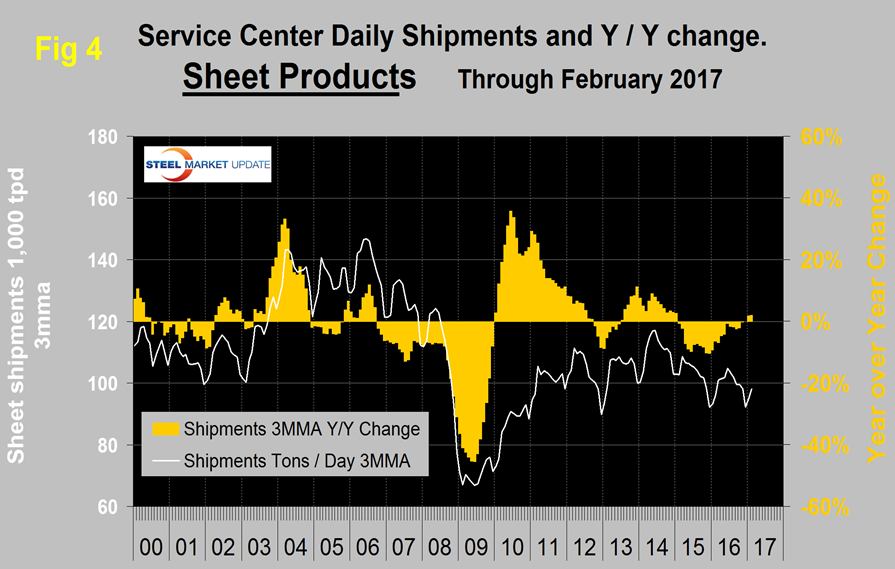Steel Mills

Service Center Intake, Shipments and Inventory through February 2017
Written by Peter Wright
March 22, 2017
February service center shipments were almost exactly normal on a month/month basis though there were some bright spots. Daily shipments decreased by 0.6 percent from January. Since 2009 on average, February has decreased by 0.8 percent. Carbon steel shipments were 148,900 tons per day. The number of shipping days decreased from 21 to 20.
![]() Intake and Shipments
Intake and Shipments
In February total carbon steel intake at 151,900 tons/day (t/d) was 3,000 tons more than shipments. This was the third month of intake surplus after three months of deficit. The deficit averaged 13,100 tons in the three months through November. Total sheet products had an intake deficit of 500 t/d in February.
Total service center t/d carbon steel shipments decreased from 151,500 tons in January to 148,900 in February. MSCI data is quite seasonal and we need to get past that before commenting in detail on current results. Figure 1 demonstrates this seasonality and why comparing a month’s performance with the previous month is usually misleading.
Last month we were concerned that the excellent shipment result for January might have stolen from February. It didn’t. In the SMU analysis we always consider year over year changes to eliminate seasonality, our intention is to provide an undistorted view of market direction.
Table 1 shows the performance by product in February compared to the same month last year and also with the average t/d shipments for this and the two previous months of February.
We then calculate the percent change between February 2017 and February 2016 and with the most recent 3 year February average. February this year was up by 3.0 percent from February 2016 but was still down by 1.3 percent from the three year February average. The fact that the single month y/y growth comparison is better than the three year comparison suggests that momentum is positive. Shipments of all products except carbon pipe and tube were up from February last year and shipments of all products were down compared to the 3 year average. Figure 2 shows the long term trend of daily carbon steel shipments since 2000 as three month moving averages (in our opinion the quickest way to size up the market is the brown bars in Figures 2, 3, 4 and 5 which show the percentage y/y change in shipments.)
In January on a 3MMA basis there was positive y/y growth of 0.07 percent which improved to 1.68 percent in February. These were the first positive y/y result since February 2015.
Figure 3 shows monthly long product shipments from service centers as a 3MMA with y/y change.
Growth was positive 2.9 percent y/y in February which was the first positive result in two years and followed a 2.3 percent contraction in January. Sheet and plate have performed very differently in the last two years. Sheet and plate products both had a good post-recession recovery. Both had some contraction in 2013 and growth in 2014 but since early 2015 they have diverged dramatically with plate performing much worse than sheet. Figures 4 and 5 show the 3MMA of t/d shipments and the y/y growth for sheet and plate respectively.
In 2006 and 2007, the mills and service centers were operating at maximum capacity, Figure 6 takes the shipments by product since that time frame and indexes them to the average for 2006 and 2007 in order to measure the extent to which service center shipments of each product have recovered.
Each year all products experience the December collapse and January pick up. The total of carbon steel products is now at 70.1 percent of the shipping rate that existed in 2006 and 2007, with structurals and bar at 50.7 percent and 54.7 percent respectively. Sheet is at 80.3 percent, plate at 69.0 percent and tubulars at 65.0 percent.
Inventories
February closed with months on hand (MoH) of 2.31 for all carbon steel products, which was down from 2.76 at the end of December and up from 2.15 at the end of January. Structurals, bar sized shapes and carbon plate had an increase in MoH year over year. Sheet products and tubulars decreased. Figure 7 shows the MoH by product monthly since February 2009.
All products had a surge in months on hand in July 2016 driven not by an inventory volume increase but by a decrease in monthly shipments as a result of a small number of shipping days. Figure 8 shows both the month end inventory and months on hand since February 2008 for total sheet products. Total inventory tonnage of sheet products has been in decline for over a year.
SMU Comment: In Figures 2, 3, 4 and 5, the white lines show t/d shipments. There was a decline in shipments for total carbon steel products since mid 2014 but the y/y decline halted in January and February this year. Figure 10 shows the total supply to the market of long and flat products based on AISI shipment and import data through January which is the latest data available.
Total supply of long products is much better than the MSCI report of service center shipments with a volume almost double the recessionary low point. Total supply of flat rolled products peaked in October 2014, declined through November 2015, recovered through August 2016 then was flat for the remainder of 2016 and recovered in January 2017. For flat rolled the MSCI and AISI data have been in reasonable agreement with one another.
The SMU data base contains many more product specific charts than can be shown in this brief review. For each product we have ten year charts for shipments, intake, inventory tonnage and months on hand. Some readers have requested these extra charts for a particular product and others are welcome to do so.

Peter Wright
Read more from Peter WrightLatest in Steel Mills

CRU: Tata Steel looks to shed 1,600 jobs in the Netherlands
The company said, “The challenging demand conditions in Europe driven by geopolitical developments, trade and supply chain disruptions and escalating energy costs have affected the operating costs and financial performance."

Reports: Federal funding for Cliffs’ project could be slashed
Elon Musk's DOGE is determining which Department of Energy grants to advance and which ones to terminate, according to several media outlets

Trump still against selling USS to Japanese firm: Report
Despite ordering a new review of Nippon Steel’s bid for U.S. Steel, President Trump said he is still against selling USS to a Japanese company, according to media reports.

Algoma looks to sell more steel in Canada in wake of Trump’s tariffs
The Canadian steelmaker said its absorbing higher tariffs as it moves forward.

Ancora abandons plan to take over leadership of USS
Investment firm Ancora Holdings Group has halted its play for U.S. Steel's board, citing Nippon Steel’s proposed bid for USS “gaining momentum.”










